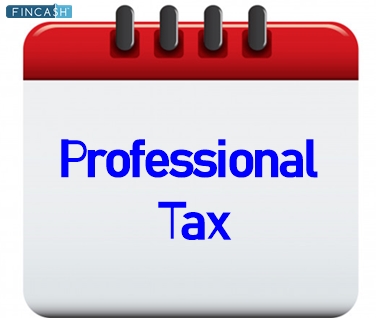Professional Tax in India - Tax Slab FY 25 - 26 & FAQs
professional tax is a tax levied at the state level in India. It is collected by the State Government by every individual who earns a living through mediums like trade, employment, or professional. Individuals who practice and earn through profession, such as a Company Secretary, Lawyer, Chartered Accountant, Cost Accountant, Doctor or are a Merchant/ Businessperson are liable to pay professional tax in some states of the country. Professional tax is payable by private company employees or by people who earn a salary in general.

Clause (2) of Article 276 of the Constitution of India provides the right to the State Government for levy and collection of professional tax or tax on the profession. Professional tax is levied through predetermined tax slabs and is paid on a monthly Basis. Some of the states which currently impose a professional tax in India are Maharashtra, Gujarat, Andhra Pradesh, Kerala, Tamil Nadu, Karnataka, Bihar, Assam, Madhya Pradesh, Telangana, Meghalaya, Odisha, West Bengal, Sikkim and Tripura.
Although the tax is levied depending upon the Income of the individual, the maximum amount any State can levy as Professional Tax is restricted to INR 2,500. The deductions of Professional tax are made under Section 16 of income tax Act, 1961. And, the balance amount shall be calculated as per the slabs applicable.
How to Calculate Professional Tax?
Individuals can calculate their Professional Tax Liability on the basis of the gross salary and tax slab prescribed by the state government levying Professional Tax. The slab rates differ from state to state.
For the illustration purpose, we have taken Andhra Pradesh for the Professional Tax rates-
- Gross income up to INR 15,000 there will be no tax
- For INR 15,001 to INR 20,000, it is INR 150 per month
- For INR 20,001 and above, it is INR 200 per month
Professional Tax Exemption Clauses
The exemptions for the Professional tax are:
- Parent or guardian of a physically challenged or mentally retarded child
- A person suffering 40 percent or more of permanent physical disability or blindness
- An assessee has completed 65 years of age. For the state of Karnataka, it is 60 years
*Note- The above provisions can vary in different states.*
State-wise Professional Tax Slab FY 25 - 26
Here's is the list of Professional Tax Slab for different states-
Professional Tax Slab in Maharashtra
| Monthly Salary (INR) | For Men | For Women | Tax Per Month (INR) |
|---|---|---|---|
| Up to INR 7,500 | Nil | Nil | INR 0 |
| INR 7,501 – INR 10,000 | INR 175 | INR 175 | INR 175 |
| Above INR 10,000 | INR 200 (INR 300 in Feb) | INR 200 (INR 300 in Feb)* if > INR 25,000 | INR 200 (INR 300 in February)** |
*Women earning up to INR 25,000/month are exempt
**INR 300 is deducted in February to meet the INR 2,500 annual cap
Professional Tax Slab in Tamil Nadu
| Monthly salary | Tax per month |
|---|---|
| Up to INR 21,000 | Nil |
| INR 21,001– INR30,000 | INR 135 |
| INR 30,001– INR 45,000 | INR 315 |
| INR 45,001– INR 60,000 | INR 690 |
| Above INR 60,000 | INR 1,095 |
Talk to our investment specialist
Professional Tax Slab in Karnataka
| Monthly Salary | Professional Tax | | Up to INR 24,999 | Nil | | INR 25,000 and above | INR 200 (INR 300 in February) |
Professional Tax Slab in Andhra Pradesh
| Monthly salary | Tax per month |
|---|---|
| Up to INR 15,000 | NIL |
| From INR 15,001 to INR 20,000 | INR 150 |
| Above INR 20,001 | INR 200 |
Professional Tax Slab in Kerala
| Monthly salary | Tax per month |
|---|---|
| Upto INR 11,999 | NIL |
| INR 12,000 to INR 17,999 | INR 120 |
| INR 18,000 to INR 29,999 | INR 180 |
| INR 30,000 to INR 44,999 | INR 300 |
| INR 45,000 to INR 59,999 | INR 450 |
| INR 60,000 to INR 74,999 | INR 600 |
| INR 75,000 to INR 99,999 | INR 750 |
| INR 1,00,000 to INR 1,24,999 | INR 1000 |
| Above 1,25,000 | INR 1250 |
Professional Tax Slab in Telangana
| Monthly salary | Tax per month |
|---|---|
| Up to INR 15,000 | NIL |
| From INR 15,001 to INR 20,000 | INR 150 |
| Above INR 20,000 | INR 200 |
Professional Tax Slab in Gujarat
| Monthly salary | Tax per month |
|---|---|
| Up to INR 5,999 | NIL |
| From INR 6,000 to INR 8,999 | INR 80 |
| From INR 9,000 to INR 11,999 | INR 150 |
| INR 12,000 and Above | INR 200 |
Professional Tax Slab in Bihar
| Annual Salary | Professional Tax |
|---|---|
| Up to INR 3,00,000 | Nil |
| INR 3,00,001 to INR 5,00,000 | INR 1,000 |
| INR 5,00,001 to INR 10,00,000 | INR 2,000 |
| Above INR 10,00,000 | INR 2,500 |
Professional Tax Slab in Madhya Pradesh
| Monthly salary | Tax per month |
|---|---|
| Upto INR 2,25,000 | NIL |
| INR 22,5001 to INR 3,00,000 | INR 1500. INR 125 Per Month |
| INR 3,00,001 to INR 4,00,000 | INR 2,000 annually (Deducted as INR 166/month for 11 months and INR 174 in the 12th month) |
| Above INR 4,00,001 | INR 2500. INR 208 Per Month For 11 Months And INR 212 For 12th Month |
Note: The annual tax is split into monthly deductions. For example, INR 2,000 is collected as INR 166 for the first 11 months and INR 174 in the 12th month to complete the annual total.
Professional Tax Slab in West Bengal
| Monthly salary | Tax per month |
|---|---|
| Up to INR 10,000 | Nil |
| INR 10,001 to INR 15,000 | INR 110 |
| INR 15,001 to INR 25,000 | INR 130 |
| INR 25,001 to INR 40,000 | INR 150 |
| Above INR 40,001 | INR 200 |
Professional Tax Slab in Sikkim
| Monthly salary | Tax per month |
|---|---|
| Up to INR 20,000 | NIL |
| From INR 20,001 to INR 30,000 | INR 125 |
| From INR 30,001 to INR 40,000 | INR 150 |
| Above INR 40,000 | INR 200 |
Professional Tax Slab in Assam
| Monthly salary | Tax per month |
|---|---|
| Up to INR 10,000 | NIL |
| From INR 10,001 to INR 15,000 | INR 150 |
| From INR 15,001 to INR 25,000 | INR 180 |
| Above INR 25,000 | INR 208 |
Professional Tax Slab in Meghalaya
| Monthly salary | Tax per month |
|---|---|
| Upto INR 50000 | NIL |
| INR 50,001 to INR 75,000 | INR 200 |
| INR 75,001 to INR 1,00,000 | INR 300 |
| INR 1,00,001 to INR 1,50,000 | INR 500 |
| INR 1,50,001 to INR 2,00,000 | INR 750 |
| INR 2,00,001 to INR 2,50,000 | INR 1000 |
| INR 2,50,001 to INR 3,00,000 | INR 1250 |
| INR 3,00,001 to INR 3,50,000 | INR 1500 |
| INR 3,50,001 to INR 4,00,000 | INR 1800 |
| INR 4,00,001 to INR 4,50,000 | INR 2100 |
| INR 4,50,001 to INR 5,00,000 | INR 2400 |
| Above 5,00,001 | INR 2500 |
Professional Tax Slab in Tripura
| Annual Salary | Annual | Monthly | | -------- | -------- | | Up to INR 7,500 | INR 0.00 | INR 0 | | INR 7,501 – INR 15,000 | INR 1,800 | INR 150/month | | Above INR 15,001| INR 2,496 | INR 208/month (INR 212 in March) |
Professional Tax Slab in Chattishgarh
| Monthly salary | Tax per month |
|---|---|
| Up to INR 100,000 | Nil |
| From INR 100,001 to INR 150,000 | INR 130 |
| From INR 150,001 to INR 200,000 | INR 150 |
| From INR 200,001 to INR 250,000 | INR 200 |
| From INR 250,001 and above | INR 2,500 annually (Deducted as INR 208/month for 11 months and INR 212 in the 12th month)* |
*INR 212 is deducted in the last month of the financial year to complete the annual total of INR 2,500.
Professional Tax Slab in Odisha
| Monthly salary | Tax per month |
|---|---|
| Upto 160000 | Nil |
| Between 160001 To 300000 | INR 1500.00 Monthly INR 125 |
| Above 300001 INR 2400.00 | Monthly INR 200/- (Apr to Feb which will be paid in subsequent months. For the month of March INR 300 to be paid in April) |
Note: For states like Madhya Pradesh and Chhattisgarh, professional tax is calculated on an annual basis but deducted monthly. The Deduction amounts may vary in the final month to meet the INR 2,500 yearly cap.
States and Union Territories where Professional Tax is not Applicable
State
- Arunachal Pradesh
- Haryana
- Himachal Pradesh
- Jammu & Kashmir
- Punjab
- Rajasthan
- Nagaland
- Uttaranchal
- Uttar Pradesh
Union Territories
- Andaman & Nicobar
- Chandigarh
- Delhi
- Puducherry
- Dadra & Nagar Haveli
- Lakshadweep
- Daman & Diu
FAQs
1. Does professional tax differ based on which state you are filing?
A: As the state governments levy the professional tax, it differs from state to state. Each state government declares its tax slab, and you will have to check which slab you fall under.
2. How is the professional tax levied?
A: Professional tax is levied under Article 276(2) of the Indian Constitution. The employer deducts it from the salaries of the employees. It is then remitted to the respective state governments. The maximum amount of professional tax payable by an individual is Rs. 2500.
3.Does it fall under direct taxation?
A: The professional tax falls under indirect taxation. It is payable by salaried individuals or persons carrying out a particular trade or profession such as a lawyer, doctor, chartered accountant, etc., are liable to pay.
4. Do non-salaried people have to pay professional tax?
A: It is levied on all individuals who are involved in professions. In other words, they may not be salaried individuals, but carrying out a trade that produces guaranteed income. Professionals like lawyers, doctors, chartered accountants, and people carrying out other similar businesses are liable to pay PT.
5. Are there rebates available for professional tax?
A: Since the PT is paid at the end of a month, it is expected that the tax is paid after completion of a full month’s employment. In such a scenario, you cannot file for IT returns or rebate on your professional tax.
6. How is the professional tax calculated?
A: For individuals whose gross income is up to Rs. 15,000, there is no professional tax. For individuals with income ranging between Rs. 15,001 to Rs. 20,000, a professional charge of Rs. 150 per month is levied. For those earning above Rs. 20000, PT of Rs. 200 per month can be collected.
7. How do I know if I have to pay professional tax?
A: If your annual income is more than Rs.15,000, then you are liable to pay professional tax. You will have to check which tax slab you fall under and in which state you are working. Accordingly, your employer will pay the tax.
8. Does the value of the professional tax payable vary annually?
A: The professional tax amount is decided by the state government and cannot exceed Rs.2500. It tax slabs can vary year to year, but it is fixed for a given financial year.
9. Whom should I consult before paying PT?
A: If you are a salaried individual, you can discuss it with the payment department of your office. If you are an individual, you can review the tax slab and the payment of professional tax with a chartered accountant. You can also go online and check out the various websites providing insights about the same.
10. Can I pay the tax in a bank?
A: Depending on the state you are making the payment. Ideally, you can do from both online and offline mode. If you make the payment offline, then check the Bank's list where you can make the payment. You can download the form from the IT department's website, fill it up, and accordingly file the tax.
11. What PT deductions I am eligible for?
A: You will be exempt from paying the tax if you are a parent of a mentally challenged child. You will also be exempt from paying the tax, if you have a permanent physical disability or blindness. Similarly, if you are above the age of 65, you will be exempt from paying the tax. If you work in Karnataka, then the exemption is for all assesses 60 years and above.
All efforts have been made to ensure the information provided here is accurate. However, no guarantees are made regarding correctness of data. Please verify with scheme information document before making any investment.







